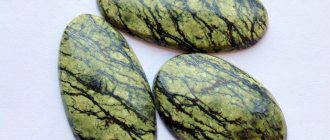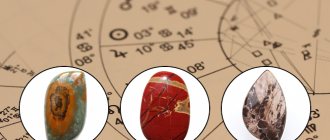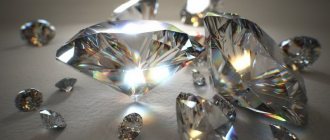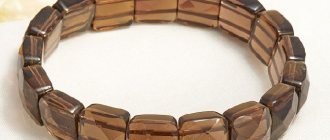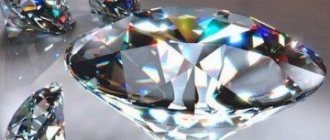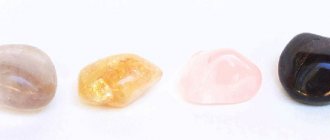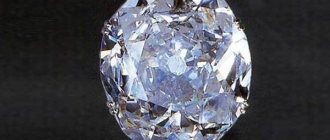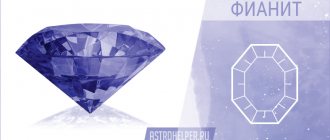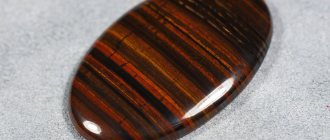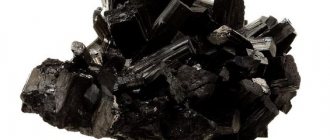In this article we will tell you how diamonds are mined and where they generally come from in the earth's crust. What do geologists, physicists, chemists, jewelers and, of course, esotericists say about these amazing stones? You will also learn about the most famous specimens in the world, the healing properties of the hardest mineral on earth, and much more.
History of the stone
Even the youngest diamonds are almost as old as our planet. They are formed in the Earth’s mantle - a natural “forge” where high temperatures and enormous pressure reign. They are pushed upward from the mantle during volcanic eruptions, when so-called kimberlite pipes are formed. Every fifth such pipe contains a precious stone, naturally uncut.
The oldest diamonds may be older than the entire solar system.
Scientists have discovered entire diamond clouds around some stars older than our Sun. Sometimes beautiful stones fall to our planet as part of meteorites. So the next time you wear your favorite diamond necklace, think about the abyss of time you are touching.
Ancient people, admiring the incredible hardness of these stones, created many myths and legends about the origin of diamonds. The main source of gems was India, and this became one of the reasons for the flair of mystery that shrouded this country already in ancient times. About three thousand years BC it was there that they first began to mine them. At that time they did not know how to process diamonds; they were simply set into gold or silver.
On the European continent
In Europe, the first gems appeared during the time of Alexander the Great, who learned about them from the conquered Persians. The war in India, which became fatal for the great commander, gave rise to many legends. For example, the battle with the Indian king Porr turned for the storytellers into a battle with monstrous dragons that guarded the diamond mines.
It was the desire to obtain previously unseen precious stones that prompted Alexander the Great to travel to India.
The oldest known name for a diamond is “fariya,” as the Hindus called it. For its hardness, the Greeks called it adamas - indestructible, and among the Romans this word turned into “diamas”. The Arabs called the stone “almas,” which translated means “the hardest.”
In most European languages, either the Latin name has taken root (English diamond, Ukrainian diamond) or Arabic, as in Russian.
A real breakthrough in the history of the most famous of gems was the invention of cutting. This happened during the Renaissance in the city of Bruges, now located in Belgium. Belgian jewelers, who became the most famous in Europe, called cut diamonds brilliants, which means “brilliant” or “sparkling.” The price of precious stones, already high, skyrocketed.
By that time, the deposits in India were almost completely depleted after four and a half thousand years of mining. But the discovery of America turned out to be very opportune: the Brazilian mines turned out to be much richer than the Indian mines, which had lost their former glory.
Diamonds can actually be made from the ashes of dead people. History of the idea
Today there is a company on the market called Algordanza. She is known for several areas of work: jewelry, funeral home. But there is another industry that it is developing. We are talking about the production of artificial diamonds from ashes after cremation. The founder of the company (Rinaldo Willi) began his activities in 2004. Such an unusual idea as the production of jewelry from the ashes of the dead arose during his student years.
This idea was prompted by an article by Russian scientists who found a way to obtain precious stones (diamonds) from the ashes that remain from garbage when burned.
The idea was developed under the guidance of a professor from the department who taught at the university where Rinaldo studied. But later an inaccuracy in the translation (misreading) was discovered. As a result, it turned out that the mistake led to a big discovery. Thanks to the confusion and the Russian scientist who published the article (with his participation), today it is possible to get a diamond from the dust. This is due to the presence of carbon, which is one of the common chemical elements in the human body. But to make stones you need to create special conditions.
Ashes of the deceased after cremation
Diamond deposits
Diamond quarry.
Diamond mining is carried out on all continents except Antarctica. The following regions are the richest in gems:
- India, especially the eastern Deccan Plateau. This is the oldest gem mining area in the world, and the reserves there are now severely depleted.
- Brazil, provinces of Minas Gerais and Bahia.
- South Africa, Cape Town region and Namibia, as well as the Transvaal. The word “kimberlite” comes from the name of the Kimberley region, where most of the stones were found. Tens and hundreds of thousands of miners from all over the world dug the famous Big Hole, extracting diamonds by hand day and night.
- Ural and Yakutia, as well as Kazakhstan.
Almost three-quarters of the world's stone production is controlled by the three largest corporations - ALROSA, De Beers and Rio Tinto. Production volumes have recently been falling, prices are rising, which encourages many people to use synthetic, artificially grown stones.
Chemical and physical properties
From a chemical point of view, the formula of diamond is extremely simple - it consists almost entirely of carbon, that is, it is, in fact, the same graphite that is used in pencil leads. Also, the diamond molecule may contain the following substances, which sometimes penetrate the crystal lattice:
- calcium;
- boron;
- nitrogen;
- magnesium;
- silicon;
- aluminum.
Pure carbon is not found in nature, and this is not necessary: it is the impurities, as well as the crystal lattice, that give the mineral its unique properties. It is its structure that provides the incredible hardness of the stone. Such a miracle of nature cannot form under the conditions of the earth’s surface; this requires the heat and pressure of the planet’s interior.
Diamond is the hardest mineral in the world.
Diamond consists of a huge number of cubic cells. These structures tightly bind together 18 carbon atoms, as well as small impurity atoms. Thanks to this structure, the stone receives a unique Rockwell hardness - maximum. Also, a gemstone, when exposed to X-rays, begins to glow in different colors. This beautiful sight also has a purely practical meaning - it is used to determine radiation.
The physical properties of a diamond have no analogues in the world of precious stones:
- The king of gems has very high light refraction and dispersion (scattering) indices. This is why the diamond plays so brightly in the sun's rays.
- The density of diamond has no equal among natural materials available to mankind.
- From the point of view of the Mohs scale, there is nothing harder than diamond; the stone receives 10 points, this is the maximum indicator. This makes diamonds impossible to scratch and very difficult to process. Although, despite the hardness of the gem, specimens with cracks are often found during mining, which jewelers have to split under pressure.
- There are almost no electrons in the crystal lattice of the main gemstone. This explains its excellent insulating properties.
- Diamonds are resistant to acids, but some alkalis can damage them.
- The melting point of the stone is three thousand degrees at a pressure of 11 gigapascals (this is very high and is only possible in laboratories).
- The burning temperature of diamond is 850-1000 degrees in air or 800 under a stream of pure oxygen.
- If you heat a diamond to two thousand degrees without access to air, its lattice begins to collapse, the stone turns into ordinary graphite and explodes. This can be considered the boiling point.
- Contrary to the established point of view, a diamond can easily be broken with a hammer or even damaged by dropping it from a height onto the floor - its strength is low.
Another unique feature of the stone that allows you to identify a fake is its high light refraction. The diamond looks very clean and transparent, but if you place it on the page of a book, you will not be able to read the text through the crystal. For this reason, diamond jewelry is never lined—the back of the setting will not be visible anyway.
Companies providing similar services
To receive a piece of the deceased as a keepsake or to give this opportunity to another loved one, you can study the offers of companies that offer to make a high-strength crystal from the ashes. This is not just an opportunity to leave a piece of the deceased, but also aesthetics, because the diamond looks the same as a natural diamond. Below are several companies that produce such stones:
| Company name, country | Cost, dollars |
| Algordanza, Switzerland | from 3000 per product 0.3 carats |
| Eterneva, USA | 2999 for a diamond |
| LifeGem, USA | To be specified individually |
Variety of shapes and sizes
Diamonds are never the same; each mined crystal is unique. But when cut, they all get one of the standard shapes. Round diamonds are the most popular because this type of cut is the most versatile and has the brightest sparkle. About three-quarters of the stones sold are round. This treatment is usually performed on 57 or 58 facets of the diamond. In order for the stone to sparkle as brightly as possible, the jeweler must maintain perfect proportions.
Sometimes a jeweler decides to create a so-called fancy variety of diamond. Most often, specialists cut fancy stones either using a wedge type (in the shape of a pyramid) or a step type. If we look at the most famous diamonds, most of them will be fancy. Which diamonds are best remembered by history?
The most famous samples
- Diamond "Orlov", the largest in the Kremlin collection. Served as the eye of a statue in one of the temples in South India. It was stolen by a certain French adventurer who deliberately converted to Hinduism and became a novice in the temple in order to get closer to the stone. The Frenchman sold the stone to Count Orlov in Russia, who presented it to Catherine the Great. The stone with a unique Indian cut became a real decoration of the imperial collection.
“Orlov” adorns the scepter of Empress Catherine the Great. - The Sancy diamond was on the beret of King Henry III. According to legend, the servant who was supposed to deliver the stone to the court was killed, but before his death he swallowed the stone so that it would not go to the robbers. During the French Revolution, the jewel was lost, but was later returned to the Louvre.
- Diamond "Kohinoor", or rather “Koh-i-Noor”, which means “Mountain of Light”, was the main treasure of the Mughal dynasty ruling in India. It did not bring happiness to almost anyone; almost all of its owners became victims of deceit or intrigue. It once weighed almost 800 carats, now it weighs just over 120. Since 1850, when the stone was presented to Queen Victoria, it has adorned the crown of Britain, and is currently worn by Elizabeth II.
Kohinoor is in the root of Queen Elizabeth II of England. - Hope Diamond, named after the American banker who bought it in the 19th century, has earned the reputation of being cursed. Almost nothing is known about its history - neither where it was mined nor which jeweler shaped it. There is a version that this stone used to adorn the statue of the Indian goddess Sita. Accidents that plagued its owners were attributed to the wrath of the Indian deity or her husband, the powerful hero Rama (his exploits can be read in the ancient Indian poem “Ramayana”). Currently, the “curse” has been taken over by the Smithsonian Institution, one of the largest in the United States. The price of the stone is three hundred and fifty million dollars, it is perhaps the most expensive diamond in the world.
Hope Stone at the Natural History Museum in the United States. - Regent's Diamond was found in 1698. The man who found it was killed by the captain of the guard, who then sold the treasure. This uniquely colored stone was worn by Marie Antoinette and Napoleon III. It is now on display in the Louvre.
The Regent's Diamond in the sword of the French monarch Napoleon III. - The Shah Diamond was mined from the Golconda mines in the sixteenth century. It was worn as a talisman. The names of three powerful Indian rulers are engraved on the stone - Nizam Shah, Shah Jahan and Fatah Ali, to whom it belonged. Then the diamond came to Persia, and from there to Russia. It was presented as compensation for the murder of Griboyedov.
- «Star of Africa", or "Cullinan", is considered the largest gemstone in the world. It was discovered in South Africa in 1905. Two years later, the government of the Transvaal colony presented it to King Edward VII for his name day. According to legend, a jeweler who was ordered to break the stone into fragments (it was too large to cut entirely) fainted from excitement. Several pieces of jewelry were made from the remains of the Cullinan for the royal family.
Star of Africa before and after division.
Of course, it is unlikely that you will ever be able to purchase one of these famous stones. However, do not despair: jewelers often make copies of them. The material for them is usually Herkimer diamond, better known as rock crystal. Technically, this mineral belongs to quartz, and not to diamonds, but in appearance it is almost indistinguishable and can be easily processed.
Can diamonds cause harm?
There are many dark stories surrounding these mystical stones, which is not surprising given human nature and the cost of diamonds. And the more expensive the diamond, the more scarlet the shade of blood in its divine radiance.
Almost every famous diamond is an active participant in historical events. Blood is abundantly sprinkled on the blue “Hope”, the magnificent “Orlov”, the famous “Kohinoor”, the sunny “Sansi” and other famous diamonds. The larger the stone, the more powerful its energy, which can sometimes awaken dormant vices in people.
View all rings from the “Diamonds of Yakutia.Premium” collection in the SUNLIGHT catalog
If the stone suppresses the owner, negative character traits begin to intensify: the person becomes arrogant, narcissistic, tough to cruelty, greedy for money and pleasure.
Or maybe the energy of the stone has nothing to do with it. It’s just that sometimes the thirst for money-grubbing pushes people to incredibly cruel acts, and a large diamond is just a trigger for activating the lowest passions.
Perhaps the most “bloody” is the incredible blue Hope Diamond. He has many deaths, bankruptcies and broken destinies. The series of tragedies only stopped when the last owner, jeweler Harry Winston, simply donated it to the Smithsonian Museum.
Diamond color range
Diamonds can be found in almost every color of the rainbow.
The color of a diamond is influenced by many factors, in particular, impurities in the crystal lattice. So-called “pure water” stones are highly valued by jewelers. These are diamonds without any shades at all. However, most often, jewelry still has a slight color tint, or tint; a perfect white diamond is very rare.
Yellow
When several carbon atoms are replaced with nitrogen, a yellow diamond is obtained. The shades vary depending on the number and arrangement of nitrogen atoms. Most of all, jewelers value stones that are dark yellow, almost amber in color; they are set into jewelry made of pure gold.
Red and pink
In Australian kimberlite pipes you can find two unique varieties of gemstones: red diamond and pink diamond. The first one comes across much less often and costs a fortune.
Brown
There are also brown stones of a wide variety of shades, from “champagne” to “chocolate”. Science still doesn’t really know how these gems are formed, which makes them even more mysterious.
Blue
Blue diamond is obtained when some of the atoms in the crystal replace boron. Such stones are also highly prized by collectors.
Blue
The blue variety becomes a decoration for private collections. However, recently methods have been developed for “refining” ordinary stones in laboratory conditions, and the most common enriched colored diamonds are precisely those of an azure hue. Therefore, their prices have dropped slightly.
Green
The type of diamond that has been exposed to natural radiation for a long time is called green. There is no need to be afraid, such gems are absolutely safe for humans, and the deep malachite or emerald hue gives them a special charm.
Black
Black diamond consists of a huge number of small intergrown crystals; it is the most durable, expensive and beautiful known.
Violet
When pink gem crystals grow together in this way, unique purple stones are formed, and they are valued no less.
As you can see, the color of a diamond is mainly influenced by its chemical composition and some other natural factors. Man has learned to enrich natural crystals and “ennoble” them, but natural stones are always valued more by both jewelers and magicians.
For mystical purposes, it is better to buy a regular “rainbow” diamond with color than an expensive and unique artificially enhanced one. We will talk further about how to distinguish a natural gem from a synthetic one.
Description and characteristics
The chemical composition of diamond is similar to graphite. But visually the stone does not look like it at all. This is due to the difference in the arrangement of carbon atoms. Many scientists have been involved in the description of diamonds. The molecular weight of the mineral was determined to be 12.01. Colors can vary from colorless and white to red and black.
According to the mineral hardness scale (Mohs scale), diamond is the hardest mineral on earth. The properties that are characteristic of this stone are amazing shine and high hardness parameters. Diamond leaves scratches on corundum, which cannot be damaged by any other material.
How to check a diamond for authenticity
Thanks to the development of the chemical industry and jewelry, purchasing artificial diamond has become easier than ever. Such stones allow you to create very skillful crafts without special equipment, so they are in demand among poor people. Problems begin when a fraudster tries to pass off synthetic gems as natural and sell them at the appropriate price. Or if you are looking for a piece of jewelry for a talisman, man-made crystals will not work.
Be careful when purchasing jewelry with stones. Quite often, the fake looks exactly the same as the natural mineral.
To distinguish a real crystal from a laboratory one, perform one or more experiments from this list.
- Diamonds play in the light, scattering the rays. If the light is not refracted and no sparkles appear on the surface of the gem, it is a surrogate diamond.
- Place the product under an ultraviolet lamp. A glass fake will not glow.
- Real stone is not afraid of scratches and abrasions. Look closely at the crystal under a magnifying glass. Roughness and abrasions will indicate a fake made of cubic zirconia or rock crystal.
- Jewelers have special fat markers. On a natural diamond they leave a clear and even straight line. On fakes there is a broken dotted line.
- Breathe on the gem. Real stone will not fog up.
- Immerse the crystal in acid. It is not scary for natural gems.
Usually the most skillful fakes are either rock crystals or cubic zirconia - stones that the FIAN learned to make back in Soviet times. To an inexperienced person, they are almost indistinguishable from what a natural diamond looks like. But with careful inspection, there is every chance of acquiring an authentic and durable piece of jewelry.
How to wear diamond jewelry correctly?
To avoid any negative consequences, the product should be worn according to certain rules that instill in the owner a sense of style and respect for the accessory:
- Diamonds do not tolerate dirt or untidiness. Before leaving home, make sure that the inlay is absolutely clean, without any traces of grease or dust around the cast.
- Don't overdo it with the number of jewelry you wear at the same time. In everyday life, a maximum of two products are recommended in a set; for a festive look, a third is allowed, for example, earrings, a ring and a neck pendant.
- Be careful when combining a gem with semi-precious stones, especially when the inexpensive insert is much larger. This way you create dissonance in the composition and the entire style.
- Diamond, along with pearls, is called the best option for a bride’s wedding jewelry. The unique shine harmonizes perfectly with mother of pearl.
And most importantly, store precious items separately from each other, in different drawers of the box. You may not believe in mysticism, but once you see how deep scratches a diamond cut leaves on less hard crystals, it will be too late.
Areas of application
Not every uncut diamond found in nature becomes jewelry. Only 15% of gems are suitable for jewelry needs. Another 45% are so-called near-jewelry, that is, they are not suitable for jewelry on their own, but can be used in combination with larger and purer stones.
Small pebbles and fragments remaining after processing are used as an abrasive material. The use of Carbonado type diamonds is widespread in industry. This is the name given to dark crystals that are unsuitable for jewelry processing, but very durable. Diamond is a precious stone not only for jewelers, but also for many other people, because it is used:
- In surgery. The cutting edges of crystal-coated scalpels allow you to make very precise, thin and neat cuts. This reduces wound healing time and allows less damage to surrounding tissue.
- In the design of complex devices, due to its heat-insulating properties. The stone allows you to get rid of possible overheating.
- In telecommunications, for its strength and ability to withstand voltage surges.
- In the mining industry, for cutting granite or creating drilling rigs.
It is too expensive to use natural stones for all these needs, so the invention of synthetic gems in the second half of the twentieth century was very helpful. They are produced from ordinary graphite at high pressure and temperature, simulating conditions in the bowels of the earth. Such stones are often enriched with metal alloys and irradiated with radiation. They are only suitable for industrial needs; jewelry with diamonds cannot be made from them.
How often are diamonds from ashes ordered?
The cost of a diamond is quite high. This means that the service of making a diamond from the ashes of the deceased is intended for people with an above-average level of income. Moreover, the number of orders for creating diamonds is constantly growing. Already now, in 1 year, there are more than 1 thousand people who died and were cremated using this technology. Moreover, it is noted that most often orders of this kind are made in the East (mainly in Japan).
Medicinal properties
Diamond is very popular among lithotherapists.
The energy of these stones is very powerful, thanks to which people use them to treat diseases of the lungs, stomach, liver and kidneys. Even the most serious diseases can recede under the influence of a diamond. The gem also perfectly reduces the activity of inflammation and gets rid of skin diseases. The properties of diamond allow it to improve mental state. Gems help with schizophrenia, neuroses, and sleep problems. Diamond can also stabilize blood pressure and normalize blood circulation.
Precious stones have long been considered symbols of maternal happiness. Therefore, diamond jewelry is perfect for pregnant women and women giving birth, reducing the likelihood of complications and diseases of the fetus. Diamond can help where all other magical tricks have failed.
Lithotherapists strongly recommend using diamonds to heal wounds, including after operations. Water infused with a precious stone is especially helpful for this purpose. Simply put the pebble in water for a day, and drink the charged water for the next 24 hours.
Magic properties
Magical properties have been attributed to gems since ancient times. Diamond is a very powerful stone, and people have always felt this. It collects positive energy, thereby strengthening a person’s aura. This is its main property.
However, this mineral has several more important nuances. It is believed that a diamond is not worth buying for yourself. For a stone to reveal its full magical potential, it must either be received as a gift or found (and cut) yourself. Then the stone will be able to strengthen human energy. The King of Gems is an extremely powerful amulet that wards off any evil from the owner.
In ancient times, it was believed that if you hold a gemstone in a drink, it can neutralize any poison.
It can also strengthen the “inner core”, make a person more courageous and resilient. The treasured amulet will make even an extremely timid person a brave warrior.
Diamonds are also used for love spells. It will help single people who cannot find their partner for a long time to become happy. This was known even in ancient India. To ensure a strong marriage and eternal love, the hands of the newlyweds were sprinkled with diamond dust. Nowadays, it is believed that a diamond ring should be worn on the left hand as long as possible. This will help you find a suitable life partner.
Colored diamonds have great magical significance, especially yellow ones, or, as they are also called, “snake eyes”. They can only be used by powerful shamans, preferably practicing one of the continuous tribal traditions. An ordinary person simply interested in esotericism is unlikely to be able to withstand his wild energy.
Can a diamond harm its owner?
Most people prone to mysticism agree in one opinion - a gemstone is 100% likely to be dangerous for the new owner if it was obtained dishonestly. It doesn’t matter whether we are talking about outright theft or a fraudulent purchase for pennies, the mineral is able to recognize the negative energy of the one who holds it in his hands. An honest person has nothing to worry about.
Another point that the traditions of a number of cultures point to is the incredibly powerful energy hidden in a transparent pebble. It is believed that over the millions of years it takes to form a crystalline structure, they accumulate the power of the earth. If you have insomnia and feelings of anxiety, do not wear jewelry too often, take a break from it.
The last piece of advice follows directly from the previous one. People who feel energized and nervous when wearing jewelry are advised to remove it before important business meetings where they need to remain cool and reasonable. In addition, the rules of business etiquette in most countries do not encourage an abundance of accessories on colleagues.
Who is suitable according to their zodiac sign?
Diamond is a very diverse mineral, including in terms of energy. It is best to use white diamonds in talismans; in this sense, they are the “softest”. The mineral is ideal for Aries, Leo and Sagittarius , with whom it will harmonize perfectly. Representatives of these zodiac signs will become even bolder and more inventive in realizing their big plans.
Another sign that would be well suited for the gem is Libra . Thanks to him, they will get rid of obsessive doubts, indecision, and will be able to gain self-confidence. The value of diamond as a stone for decisive and firm people makes it unsuitable for Pisces and Cancers , their innate qualities will conflict with decoration.
For other Water signs, a blue stone is suitable. On the contrary, red diamonds are recommended for fire signs, and green or brown ones for earth signs. White stones can be worn by everyone except Pisces and Cancers.
